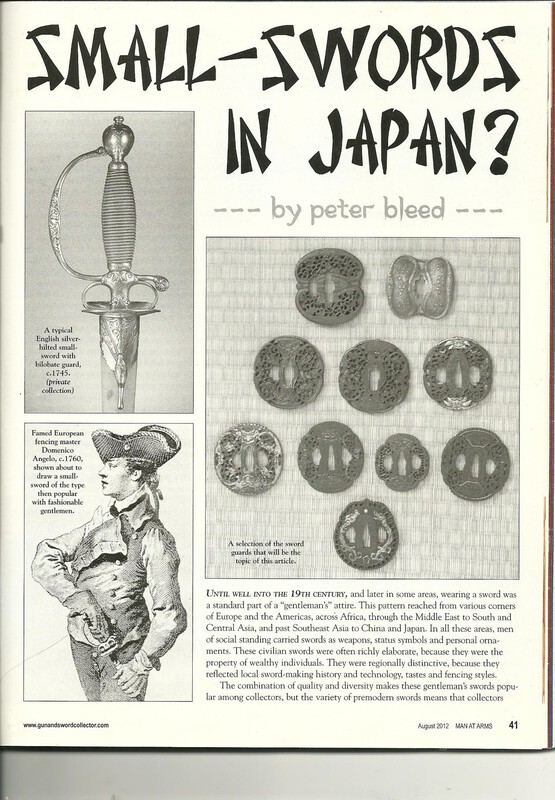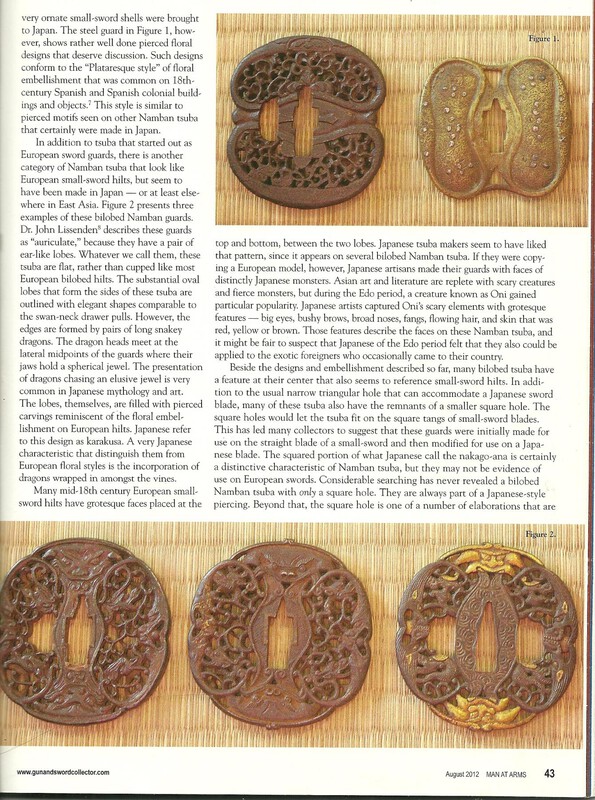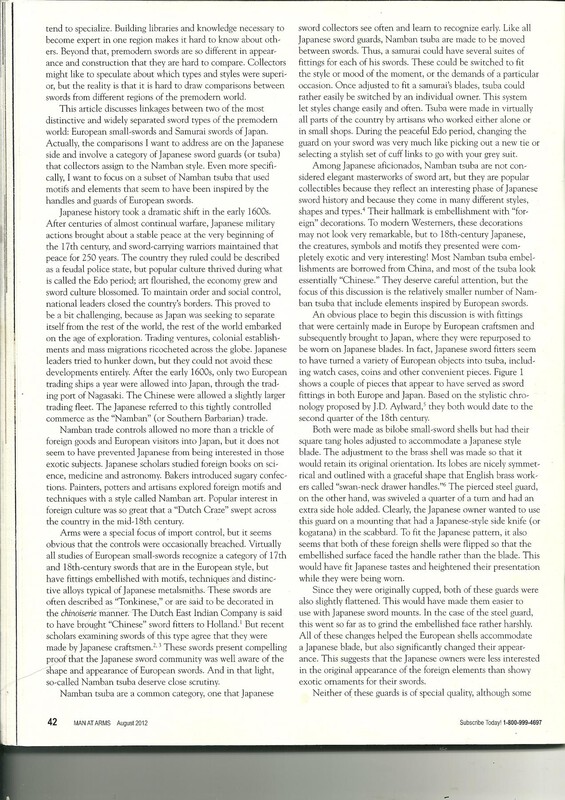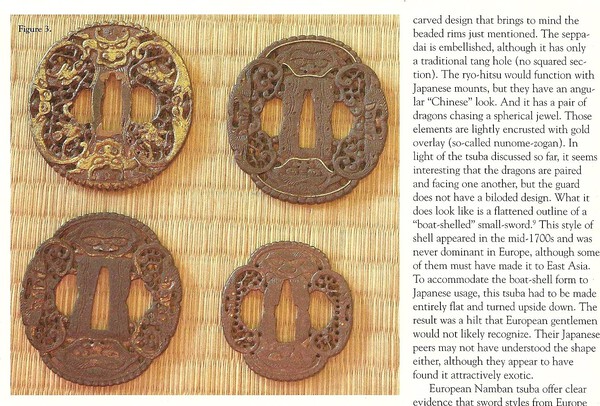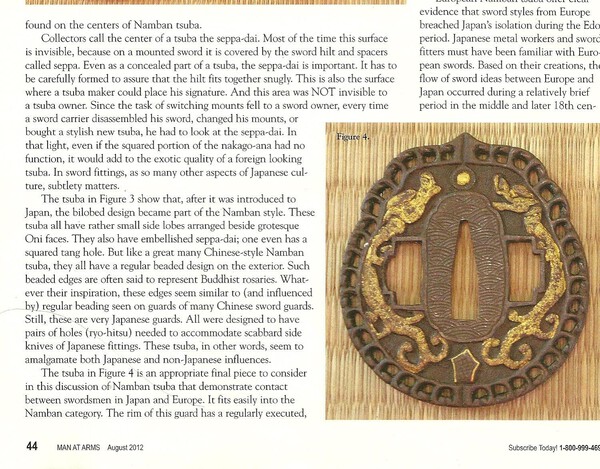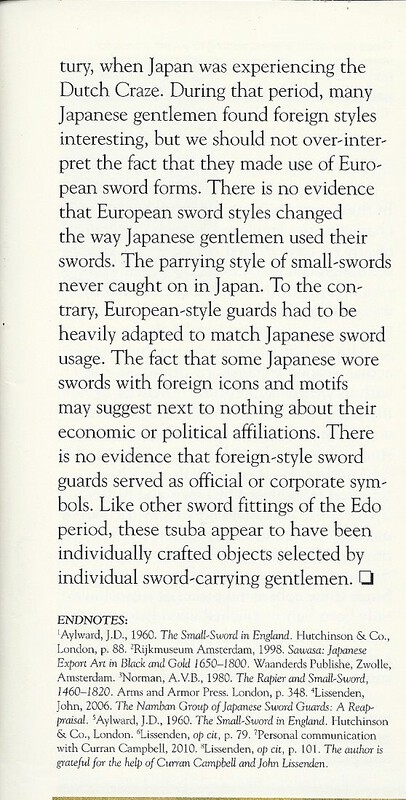
Peter Bleed
Gold Tier-
Posts
1,836 -
Joined
-
Last visited
-
Days Won
8
Everything posted by Peter Bleed
-
General Development Collecting Nihonto/tosogu
Peter Bleed replied to BIG's topic in General Nihonto Related Discussion
"Regarding Peter Bleed's lamentation about a sword that won't go beyond T. Hozon: They can't all pass to Juyo, even if they are good candidates. If all swords that were worthy passed to Juyo, then there would be no sense of accomplishment and no real reward." In addition to the spoon feeding, many in the current generation seem to be completely humorless and without any appreciation for IRONY. I was making a JOKE. Peter -
General Development Collecting Nihonto/tosogu
Peter Bleed replied to BIG's topic in General Nihonto Related Discussion
This has been an interesting thread. It is indeed fun to think about why and how we collect. Given the expert insights that have been presented, I enter this discussion with some hesitation, but... As others have expressed, it truly seems like sword collecting is less popular than it was - say - 35 years ago. There are lots of reasons for this decline - less stuff to be discovered, rising prices, competitive diversions, etc. etc. Let me suggest another reason. Sword collecting isn't as much FUN as it used to be. In the Valhallic days of yore, a regular guy could find stuff to look at, could afford it, and with a few books could learn about it. Regular guys with a little brass hammer and a couple of rather easily obtained "rare books" could "identify" swords. This would involve spending some time "reading" signatures and then deciding if they were "good." Those activities took some time. They often involved interacting with other collectors - face-to-face. Expertise was at a VERY low level. The kantei practiced in the old days was naive ("I think it's koto, maybe Bizen") but it was sincere and reasonable, and based on personal inspections and judgement. It was an achievement Contrast that with today In the rationalized modern market, easily assessed worthy blades are not common. Furthermore, basic information is widely available. so collectors are rarely presented with totally unsolved challenges. The gun slick with a sword for sale can often tell you what the signature says. And if a collector IS confronted with an identification challenge, the OLD fun it getting the books out, scratching the head, checking alternatives, and finally coming to something a personally achieved DECISION, is replaced by appeal to an old guy who is "expert" or to posing an image on the NMB and getting an answer back in minutes. WHERE IS THE JOY? Furthermore, modern sword collecting has become so well organized that individual collectors no longer get to freely decide with is worth having. The categories have become very closely refined - so that it takes a real expert to appreciate them. Furthermore, we are now confronted with VERY refined standards of quality. Beyond being told very specifically what our swords are, we can now find out how GOOD they are. In this context, the joys of discovering, assessing, and preserving are being replaced by the disappointment of learning that a sword won't go beyond Tokubestsu Hozon. Don't you hate it when that happens? Peter -
I apologize for the problems. It is nice to see that some people actually like to see the "words" sections as well as the pictures! I'll try solve the pages 2 and 5 problem. sorry! Peter
-
Dear Friends, Given the lingering interest in Namban tsuba,my goal here is to post copies of an article I published a couple of years ago in "Man At Arms". For those who don't know about it, "Man at Arms" is a serious arms collectors' magazine that has a solid following - mainly among gun collectors. The magazine also seeks to speak to sword collectors so I felt a serious piece on a Japanese topic would be interesting to other arms collectors - and good for Nippon-to collecting. With permission, copies of the paper are attached. Enjoy Peter
-
Attention Namban Collectors ....
Peter Bleed replied to nagamaki - Franco's topic in Auctions and Online Sales or Sellers
A great thread. Thank you all,I should perhaps send this directly to Ted since I want to speak to the specific question he asked. But let me share it with the Forum. The guard that Ted showed us is handsome, well-crafted, and unusual. It is the kind of thing that ANY Namban collector would want to look at closely. I tried to express respectful reservation about the significance of the attached cross. I also may have hinted that Japanese authorities may not have complete expertise (and sympathy) for Namban materials. My major goal was, however, to say that there are MANY different sides to the topic of Namban fittings. And for that reason, even really excellent pieces won't be to every Namban collector's taste. Peter -
Attention Namban Collectors ....
Peter Bleed replied to nagamaki - Franco's topic in Auctions and Online Sales or Sellers
Ted has shown us the Holy Grail, with an NBTHK paper, yet. Still, I am not sure this guard will command the full attention of Namban collectors. I certainly won't argue with the Hozon judges, but...I am suspicious.. Let's say there are at least three different sides to Namban kodogu 1. Most Namban fittings reflect a Japanese popular interest in "Foreign" motifs. This is like Texans wearing Navajo jewelry - because they like how it looks. There was a fad called "Rampiki' that had lots of Edo period Japanese dandies wearing what they saw as "Dutch" stuff. This fittings are interesting because it reflect Edo period Japanese popular culture. The great bulk of Namban koshirae IMHO is this kind of stuff. 2. Closely related to that stylish stuff, there seems to have been some Japanese who liked truly exotic fittings that could be adjusted to Japanese swords. This includes fittings from China, Korea, and even Europe. For collectors this kind of fitting is interesting because it reflects the international side of Japanese civilization. There was an international side to the Edo period, but some of this stuff MAY date from the pre-Edo period. My personal opinion is that MOST of these materials dates from the Edo period. 3, Finally, there MAY be some "Namban" stuff that reflects membership in political, commercial, or sectarian groups."VOC" on a tsuba might mean a guy was working the Ditch East India Company, but every kid wearing a Steelers jersey is not a pro football player. The Cross on Ted's tsuba would get the wearer killed after the early 1600s. That presentation also hardly qualifies as as a "Hidden" presentation. It is a fine tsuba, but I am suspicious, Since the Meiji period there has been interest in the "Kakure Kirishitan" and a market for evidence of Christianity in Japan. How can we be sure that the cross was not a rather later addition to tsuba that would otherwise fit in category #1 above? Peter -
Authentic Ww2 Japanese Cavalry Sword?
Peter Bleed replied to barnejp's topic in Military Swords of Japan
Now that Steve has broken the ice, I will go another step farther. IF I had this sword i would also like to sell it to you (or anyone else). Peter -
Is There Anything Special About This - Pistol
Peter Bleed replied to Daso's topic in Tanegashima / Teppo / Hinawajū
I just ran a quick count and it looks like there a half dozen netsuke/miniature guns being offered on eBay. For years and years you just didn't see any at all.Now they are available - - Old collections being dispersed? A change in Japanese gun laws? Some guy went into production? Peter -
Is There Anything Special About This - Pistol
Peter Bleed replied to Daso's topic in Tanegashima / Teppo / Hinawajū
This is, indeed, a neat little gun.It looks like wonderful work . Still, I have to say that it SEEMS to me like there have been a large number of these little matchlocks showing up - on eBay and elsewhere - recently. Do others have the same impression - and if so, how can we explain this sudden burst in their numbers? Peter -
Mei I Ask Your Assistance?
Peter Bleed replied to mywifesgunakillme's topic in Translation Assistance
1944 signed Masanori. A thousand bucks? Any chance your kids will wan to go to college? -
I have only on thing to say, Dhaaaa, or at least Dha. The presence of Japanese blades in Southeast Asia is a very interesting problem. I hope you will look closely at how the hilt was seated on this blade. It may not be Japanese mounting, but I would not be surprised to see that it was a seriously re-purposed weapon. There were as well a bunch of Japanese fighters who got to SE Asia. I thnik this was a nice find and if you can get any history, so much the better. See if the dealer has a scabbard. too! Peter PS, In looking again, I have to wonder about that "bump" on the side of the hilt. Are we sure that that is NOT a meguki sort of thing? Sure looks like it is positioned about right.
-
Iwami no Kami Nobuyori. A serious Echizen guy And I agree that scabbard (?) looks Southeast Asian Very interesting Peter
-
Ancient Inscription On Sword
Peter Bleed replied to Carlo Giuseppe Tacchini's topic in Translation Assistance
Not sure of the inscription, but I really doubt that this blade will survive another polish. Peter -
An interesting thread. Thanks. Irregular mekugi-ana are a feature of the first three Kunikanes of Sendai. From my experience (mainly looking at reference oshigata) these smiths often - but not always - created ana that were at least out of round. Sometimes they are rather squarish but there are also holes that are rather ovoid or simply have a "ding" in one side. I am not sure if this is a kantei point but given the frequency of gimei in this school, a collector once pointed out to me that this attribute would be very easy to "fake" - all it would take is a round file and 30 seconds. Peter
-
I think we may be working too hard on this. The English word used to describe the intervening space between design elements is "interstice". It is a technical terms but it is in common use. I was serious in recommending it, and I apologize if my contributed limerick set a poor tone. I think this is the work that Grey was looking for. Of the others that have been presented, "MA" (as in "tokonoma") might be appropriate - AFTER IT HAS BEEN EXPLAINED. Peter Humor on this sword forum runs the risk of upsetting decorum. Seems serious word collectors can be irony neglectors. Relax. If you've got beers, pour'em!
-
What we are talking about here is an interstice google it. And if you need help with pronunciation remember that famous poem An amorous girl named Knapp Had pimples all over her map But in her interstices There lurked a far worse disease, For there she supported the clap. Peter
-
Ron, I can't answer any of your questions which is typical, but I always like your stuff, and... Are we sure that is lead?. It looks pretty sturdy and fresh for old lead. Could it be one of the other "grey" metals, zinc, or tin - - - or platinum mebbe? Peter
-
Chinese Collectors Of Ww2 Blades/swords
Peter Bleed replied to barnejp's topic in Military Swords of Japan
Cracking the nut with the Chinese sword collecting community is the next big development in worldwide edge collecting. There was a time when I really wanted to study Chinese "sword guards" as they contributed to the evolution of Nanban tsuba. I have tried to seek out Chinese fittings and looked for the Chinese "base' behind tsuba that were adjusted, re-purposed, and modified to work with Nippon-to. Fittings of this type are not common. I have also not found accessible information on the historical development and stylistic diversity. It has all got to be there - it a quarter of the world! - but it sure ain't easy to find. I also have to say that much of what Japanese and Western experts have to say about Chinese sword fittings that found their way to the land of the Rising Sun seems pretty weak. The chronology especially is all over the board. The differences between Chinese guards and Japanese copies thereof are also not fully understood. Whatever it takes, we should do what we can to involve the Chinese collecting community. peter. P.S. Is it worth noting that Aoi-sama is now offering a Chinese version of his page? -
A wonderful thread. Thank you all! Peter
-
Clearly, Aoi-sama NEEDS an American outlet - somebody who can manage the dispatch of goods from an address outside of Japan and who can also handle trans-shipment of images and information from this side of the water.If Tsuruta-san can access things over here, sword collecting will expand. I think that somebody ought to view this an as opportunity. Tsuruta-san has always been pleasant and fair to me. Let's figure out a way to bring him IN. Peter
-
Ford, I think I at least tried to toss a bit in the Kickstarter kitt when this conversation opened, but I am so ham-handed in the whole computer thing that I am not sure I actually got on the list. I hope my name is there because I certainly want this book, Peter
-
KANETOSHI, mebbe?
-
Data And Details On Teppo Needed
Peter Bleed replied to Ford Hallam's topic in Tanegashima / Teppo / Hinawajū
Ford, Thank you for opening an interesting conversation. I look forward to learning a great deal. The old saw we all heard that the brass embellishments on "Onin/Heianjo" tsuba were created with repurposed Chinese coins never struck me as reasonable. But I also just can't believe that brass came to Japan along with firearms. I just have to believe that the whole situation was more complex. I have little 'data to contribute to this discussion, but I checked Kobayashi Ushisaburo's 1922 "Military Industries of Japan" which offers lots of historical details about the modern growth of the Japanese arms industries . . and Japan's 'military/industrial complex". Now obviously, this is not historical period you are directly asking about, but I you may find the following quote of interest. " From ancient times zinc ore has been commonly found in combination of copper and lead ores, but it was not much sought after for the sole reason that its presence was detrimental to the refining of copper and lead. When, as a result of the Russo-Japanese War, there came about a large demand in Japan for zinc, but no way was available to get this stuff in consequence of the disregard of the metal in the past. In the 38th year of Meiji (1905), recourse was had to the exporting of zinc ore to foreign countries in order to import it after being refined there; and since then a large amount of the ore has been exported annually…” This volume also has data on the cost of imports during the early Meiji era. It looks to me like Japan was spending a LOT of dough importing zinc.. Zince was being paid for at the same level as copper and lead, and tin. Again, I think this is a great topic and I hope you will keep pushing it ahead. Peter -
Thanks for reminding us, Peter. Dean has long been one of my heroes. Peter
-
Indentification/information Request
Peter Bleed replied to Philip's topic in Military Swords of Japan
It is easiest to understand this system if you simply remember that thee is no ZERO year. Every year gets a number and when a new era is declared, the REST of that year is "Year 1" . As I recall TAISHO 14 (which is 1925) ran until December 25 (Ho ho ho).. Pistoleros watch this closely because since Nambus are dated with a number and no kanji you occasionally find pistols dated 14.XX. These are RARE Tasiho guns and not to be confused with more common 1939 bangers. Peter


